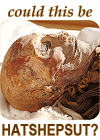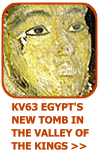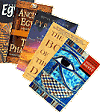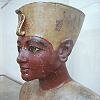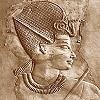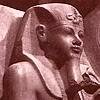|
|
|

Pages in this article: [ UNRAVELLING THE MUMMY ] [ IDENTIFYING THE MUMMIES ] [ X-RAYING THE MUMMIES ] [ USING DNA ]
Using DNA
|
With the advances in science technology, there is now a new "weapon" that can help Egyptologists in their quest to construct the definitive chronology of Egyptian kings, namely DNA testing. The process involves taking minute amounts of tissue samples from a donor that can be broken down into their constituent parts, allowing the identification of individuals, by comparisons to other none samples.
First developed and used as an identification technique in 1985 [xvii]. DNA testing underwent further refining until in 1991, a process known as Polymerase Chain Reaction (PCR) was developed; whereby DNA can be cloned to produce multiple copies of specific regions of human DNA. These regions can then be examined to see if they are linked genetically to other individuals.
|
|
Although DNA testing could and may be able to provide answers to the chronology and genealogy of Egypt's mummies, DNA has been termed as the "genetic fingerprint" of each individual, passing genetic information from one generation to the next by making exact replicas of its self. Therefore, the closer a genetic sequence match is, the higher the probability that the donors share a common ancestry.
Furthermore, an individual's genetic fingerprint is influenced by ones parents' genes; each contributing half of their genes to their offspring. Mitochondrial DNA (mtDNA) is inherited from the mother, whilst Nuclear DNA is derived from both parents and is much harder to obtain for study.
|
However, DNA testing is not without its limitations and is not the panacea as is often widely believed.
 |
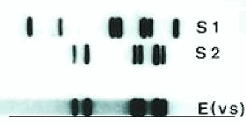 |
| DNA Replicated. This shows DNA samples decoded into its polymerase chain reaction (PCR) identity. |
By comparing a test sample E (vs) (shown bottom) against donor samples, it is evident that there is a match with the sample labelled S2.
|
[xvii] Encarta encyclopaedia 2004
The limitations of DNA
|
One of the problems of trying to harvest ancient DNA is that it is one of the first things to undergo decomposition, breaking the strands of DNA into fragments, resulting in the danger of false sequencing.
|
|
However, far and away the biggest threat in using DNA is the fear of cross contamination. If a single modern cell contaminates the sample under analysis, it becomes worthless. Therefore, it is imperative that any samples harvested are carried out under the most practically stringent conditions possible.
|
|
Through the advent of experimentation, it has been found that teeth are the best source of harvesting "clean" DNA. The outer layer is vigorously cleaned, then the tooth is drilled to gain access to the inner un-contaminated pulp, which is then pulverised and used for DNA testing.
|
|
Since mtDNA is maternally inherited, one obvious limitation is in an instance when a mother bears no daughters. Her mtDNA effectively comes to a screeching halt. Later generations will not have a trace of the former generation's mtDNA in this case.
|
|
Autosomal (nuclear) DNA is inherited from both a mother and father (50/50), which makes it more reliable to track, as it recombines. In addition to certain mtDNA becoming extinct due to the lack of daughters, we must also consider new mtDNA showing up due to new groups being introduced to a given population. This can also significantly skew any results.
|
|
Moreover, the difficulty in harvesting the father’s DNA to prove paternity, limits the value of genetic testing. Dr Hawass of the SCA has always been sceptical of using DNA citing "From what I understand, it is not always accurate and it cannot always be done with complete success when dealing with mummies. Until we know for sure that it is accurate, we will not use it in our research" [xviii].
|
|
|
[xviii] Interview with al-Ahram issue 512 |
Using DNA
|
Back in 1993-94 Professor Scott Woodward, a microbiologist from Brigham Young University (USA) was asked to demonstrate the usefulness of DNA, testing on six mummies from the Old Kingdom period, with the aim of providing clues to their sexing and possible genealogies.
Woodward was able to determine that two of the mummies had been [accidentally?] placed inside the wrong coffins.
Following his success, Woodward was invited to the Cairo Museum sometime during the mid 90’s to examine and harvest tissue samples from 27 royal mummies from the New Kingdom Period, during their removal to a new display room.
|
|
From the 27 mummies, only 7 yielded successful DNA sequences. However, from his results he was able to determine that Ahmose I had married his full sister Seknet-re and that Amenhotep I's mtDNA was different from Ahmose I, making it highly likely that Ahmose – Nefertari was in actual fact Amenhotep I's mother.
Furthermore, according to his DNA evidence, it is highly probable that Amenhotep I was Thutmosis I's father, which opposes conventional wisdom, stating that the 18th dynasty revealed "a very narrow gene pool" [xix].
However Woodward does agree with Wente and Harris on the identity of Thutmose III stating "Thutmose III is identified with a high degree of certainty".
|
|
|
|
|
The "Holy Grail" of DNA testing, would without a doubt be the comparison between Tutankhamun, Amenhotep III and Akhenaten's DNA sequences. This dream almost became a reality on December 12th, 2000, when a joint team from Waseda University in Japan and Cairo's Ein Shams University were given permission to take tissue samples.
Unfortunately, the Egyptian Government withdrew permission at the last moment. The SCA rejected the request on the grounds that it represented a threat to the mummy's fragile condition and would, in any case, prove futile.
Hawass again said DNA analysis was out of the question because it would not lead to anything [xx]. Then in 2003, Woodward was approached and given permission by the Egyptian government to harvest tissue samples from Tutankhamun. But once again, the Egyptian Government rescinded, citing reasons of "national security".
|
|
Hassan Bassiouni, a genetic researcher at Al-Azhar University, argued that it might prove impossible to establish Tut's lineage by examining the DNA samples because all cells had died many years ago and that they were probably contaminated by liquids and materials used in mummification, as well as natural erosion factors. Nasry Iskander, an Egyptian scientist who has done extensive work on mummies, says Tutankhamun's mummy was in too poor a condition for X-rays to yield any conclusive answers.
He says that in the future, DNA analysis of tissue material might help solve the mystery [xxi]. However, the Egyptian Government did grant permission for Woodward to harvest and sequence mtDNA and Nuclear DNA from Tutankhamun's eldest foetus [xxii] – to date, the results have not been published.
|
In conclusion, it is apparent that no single individual system for determining a definitive chronology works. But, by combining all the known scientific fields together, including the newest member, CT scanning, perhaps and only then, will the fields of science and Egyptology be able to finally unravel the mystery of the mummies.
|
Note: At the time of writing this article (Jan 2005), the SCA took a momentous decision and had the body of Tutankhamun removed from his tomb, in order for it to be CT scanned. It is believed that a DNA sample would be taken, whilst given the opportunity. It is hoped from the results, to finally prove whether the boy king was murdered and with the DNA samples determine his lineage. See the results here >>
|
|
|
| |
References for this page: |
| [xix] |
Secrets of the Ancient World revealed through DNA. 2001, S Woodward. |
| [xx] |
Interview with "Travel Egypt" magazine, 2004. |
| [xxi] |
Internview with Mark Rose, editor of "Archaeology", March 2003. |
| [xxii] |
http://molecular-geneaology.byu.edu/group.html
|
return to the main articles page >>
|
|
|




